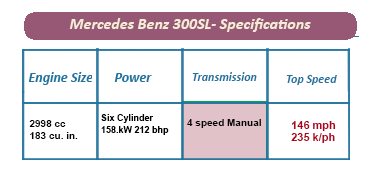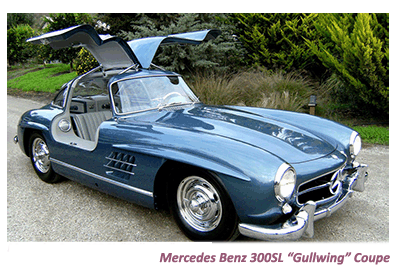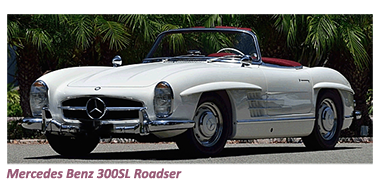 Mercedes Benz's 300 SL sports series, was, by far away. the most iconic model to evolve from the Stuttgart design workshop during the Fifties, in particular, the " Gullwing."
Mercedes Benz's 300 SL sports series, was, by far away. the most iconic model to evolve from the Stuttgart design workshop during the Fifties, in particular, the " Gullwing."
 Launched as the off-track version of Daimler-Benz's hugely successful 300 SL racing car, the two-seater closed sports car was Mercedes’ response to urgent prompting by Max Hoffman, their official US importer, who accurately foresaw an eager market for a top-quality Mercedes sports car.
Launched as the off-track version of Daimler-Benz's hugely successful 300 SL racing car, the two-seater closed sports car was Mercedes’ response to urgent prompting by Max Hoffman, their official US importer, who accurately foresaw an eager market for a top-quality Mercedes sports car.

 >America caught their first preview of the Gullwing for the first time, at the 1954 Auto Show in New York and it was an immediate sensation.
>America caught their first preview of the Gullwing for the first time, at the 1954 Auto Show in New York and it was an immediate sensation.
The Gullwing's aerodynamic streamlining was well ahead of its time, and there were very few dramatic scenarios in the mid-Fifties car industry than the almost sensual unfolding gullwing doors released the full potential of the car's inherent panache.
The moment these Gullwings unfolded themselves for the first time before the world press, Mercedes were a welcome presence in the United States.
![]()
Of the more than three thousand 300SLs produced, 75% of them passed through Max Hoffman's distributorship, around two-thirds of them Gullwings.
 With the power to match its looks, the 300SL was reportedly capable of reaching speeds of around 250 kilometres an hour ( 150 mph) although Mercedes were only prepared to guarantee about 220 kph (130 mph) from a 3 litre 193 cubic inch engine.
With the power to match its looks, the 300SL was reportedly capable of reaching speeds of around 250 kilometres an hour ( 150 mph) although Mercedes were only prepared to guarantee about 220 kph (130 mph) from a 3 litre 193 cubic inch engine.
 The three thousand plus car enthusiasts who invested in the 300SL during its three-year production run could choose from five rear-axle ratios for their preferred balance between straight-line speed and acceleration.
The three thousand plus car enthusiasts who invested in the 300SL during its three-year production run could choose from five rear-axle ratios for their preferred balance between straight-line speed and acceleration.
Coupe or roadster, all of which benefited from the Mercedes-Benz revolutionary new direct fuel injection system, another first for a petrol-powered production car and not even installed in the 300SL race-only forerunner.
 Beyond the Mercedes 300SL's most apparent feature—its gull-wing doors and super-fast acceleration also lay some technology that helped to endorse Mercedes' claim that they had created the world's first supercar.
Beyond the Mercedes 300SL's most apparent feature—its gull-wing doors and super-fast acceleration also lay some technology that helped to endorse Mercedes' claim that they had created the world's first supercar.
The 300 SLs performance was dependent not just on its lightweight aluminium skin, but on the rigidity of the tubular frame, which necessarily reached much higher than usual up the side.
Due to this high level of rigidity, the Mercedes-Benz design team rapidly concluded that regular fitting doors were an impossibility, leading to the development of the Gullwing.
![]()
 These little touches went a long way to some members of the motoring media to declare the Mercedes 300 SL`Gullwing' to be `Sports Car of the Century.'
More than six decades after its introduction, the Mercedes Benz 300 SL Gullwing can still take a car lovers breath away.
These little touches went a long way to some members of the motoring media to declare the Mercedes 300 SL`Gullwing' to be `Sports Car of the Century.'
More than six decades after its introduction, the Mercedes Benz 300 SL Gullwing can still take a car lovers breath away.
 With an estimated 1200 300SLs still in circulation, a testament to Mercedes Benz's engineering abilities, the Gullwing's ergonomic brilliance still makes it one of the most pleasing cars ever to hit the planet's highways.
Gullwing production lasted only a few years, ceasing in 1957, with its successor, the. 300SL Roadster fitted with conventional doors.
The smaller 190SL Roadster powered by an 1897-cc four-cylinder engine, sold in far more significant numbers, succeeding to remain in production till 1963.
With an estimated 1200 300SLs still in circulation, a testament to Mercedes Benz's engineering abilities, the Gullwing's ergonomic brilliance still makes it one of the most pleasing cars ever to hit the planet's highways.
Gullwing production lasted only a few years, ceasing in 1957, with its successor, the. 300SL Roadster fitted with conventional doors.
The smaller 190SL Roadster powered by an 1897-cc four-cylinder engine, sold in far more significant numbers, succeeding to remain in production till 1963.
Take me back to the Home Page


